
|
It brightened up to 6.2 mag in June (June 24, Marco Goiato). Now it is fading. It has already faded down to 10.6 mag (Aug. 8, Chris Wyatt). It will be unobservable soon in the Northern Hemisphere. In the Southern Hemisphere, it will be getting lower after this, and will be unobservable in October.
Date(TT) R.A. (2000) Decl. Delta r Elong. m1 Best Time(A, h)
Aug. 20 14 18.20 -29 19.1 2.188 2.167 75 10.1 20:13 ( 48, 6)
Aug. 27 14 18.15 -28 42.0 2.401 2.240 68 10.4 20:02 ( 51, 4)
|
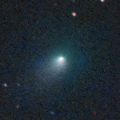
|
Now it is 10.3 mag (July 31, Marco Goiato). It keeps 11-12 mag until September. In the Northern Hemisphere, it keeps low for a long time after this.. In the Southern Hemisphere, it keeps observable in good condition for a long time.
Date(TT) R.A. (2000) Decl. Delta r Elong. m1 Best Time(A, h)
Aug. 20 14 28.52 -16 39.6 1.510 1.552 72 11.7 20:13 ( 55, 17)
Aug. 27 14 47.66 -18 53.5 1.558 1.561 71 11.8 20:02 ( 53, 15)
|
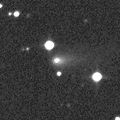
|
Now it is 12.3 mag (Aug. 12, Chris Wyatt). It is observable at 12 mag from summer to autumn, but it keeps low for some time.
Date(TT) R.A. (2000) Decl. Delta r Elong. m1 Best Time(A, h)
Aug. 20 7 20.22 19 56.3 1.996 1.358 38 12.0 3:52 (257, 17)
Aug. 27 7 43.98 18 0.8 1.981 1.360 39 12.0 4:00 (260, 18)
|

|
Now it is 11.1 mag (July 31, Chris Wyatt). It is not observable now in the Northern Hemisphere. It will be unobservable in September also in the Southern Hemisphere.
Date(TT) R.A. (2000) Decl. Delta r Elong. m1 Best Time(A, h)
Aug. 20 11 54.63 2 38.5 2.408 1.621 30 12.2 20:13 ( 94, -1)
Aug. 27 12 13.68 0 38.7 2.444 1.636 29 12.3 20:02 ( 92, -2)
|
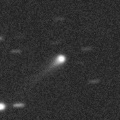
|
It brightened rapidly up to 13.1 mag (Aug. 12, A. Diepvens). It will be observable at 12-13 mag until autumn.
Date(TT) R.A. (2000) Decl. Delta r Elong. m1 Best Time(A, h)
Aug. 20 14 31.38 -14 7.1 2.083 2.029 72 12.6 20:13 ( 56, 19)
Aug. 27 14 45.02 -14 31.6 2.139 2.018 69 12.5 20:02 ( 56, 18)
|

|
It brightened up to 8-9 mag from winter to spring. Now it is fading. It has already faded down to 12.9 mag (July 23, Chris Wyatt). It will be unobservable soon. But it will appear in the morning sky at 14 mag in autumn.
Date(TT) R.A. (2000) Decl. Delta r Elong. m1 Best Time(A, h)
Aug. 20 11 55.66 10 45.2 4.374 3.523 28 12.8 20:13 (101, 3)
Aug. 27 12 1.31 9 11.6 4.478 3.580 24 12.9 20:02 (101, 0)
|

|
It passes the perihelion on Aug. 19. It is not observable now. In the Northern Hemisphere, it will be observable at 15 mag in good condition from September to October. In the Southern Hemisphere, it is not observable until November.
Date(TT) R.A. (2000) Decl. Delta r Elong. m1 Best Time(A, h)
Aug. 20 10 24.32 8 13.7 1.029 0.140 7 12.9 20:13 (112,-15)
Aug. 27 10 49.44 16 16.2 0.730 0.310 8 19.5 20:02 (118, -9)
|

|
Outburst occured on July 28. Now it is bright as 12.0 mag (Aug. 11, Juan Jose Gonzalez). It is observable in excellent condition in the Southern Hemisphere.
Date(TT) R.A. (2000) Decl. Delta r Elong. m1 Best Time(A, h)
Aug. 20 19 18.99 -25 41.5 5.096 5.911 140 13.3 21:22 ( 0, 29)
Aug. 27 19 17.08 -25 36.7 5.170 5.909 133 13.4 20:53 ( 0, 29)
|

|
It will brighten up to 13 mag in summer. But it keeps unobservable for a long time. It will appear in the morning sky in December, when the comet will be fainter than 15 mag.
Date(TT) R.A. (2000) Decl. Delta r Elong. m1 Best Time(A, h)
Aug. 20 9 31.41 7 40.2 2.412 1.417 8 13.4 3:52 (248,-16)
Aug. 27 9 55.18 5 42.1 2.406 1.413 8 13.4 4:00 (251,-15)
|
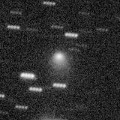
|
Now it is so bright as 12.6 mag (Aug. 17, Thomas Lehmann). It is observable in excellent condition in the Northern Hemispehre. In the Southern Hemisphere, it keeps locating low until August, but it will be observable in good condition after September.
Date(TT) R.A. (2000) Decl. Delta r Elong. m1 Best Time(A, h)
Aug. 20 22 34.81 42 45.9 1.122 1.886 124 13.7 0:44 (180, 82)
Aug. 27 21 39.30 37 19.2 1.053 1.882 131 13.5 23:10 (180, 88)
|

|
Now it is 12.4 mag (Aug. 11, Juan Jose Gonzalez). It will be fading gradually after this. In the Northern Hemisphere, it keeps observable until early November. It becomes observable in the evening sky from July to September also in the Southern Hemisphere.
Date(TT) R.A. (2000) Decl. Delta r Elong. m1 Best Time(A, h)
Aug. 20 15 14.20 30 6.7 3.272 3.156 74 13.6 20:13 ( 95, 53)
Aug. 27 15 17.61 27 4.4 3.379 3.194 70 13.7 20:02 ( 92, 49)
|
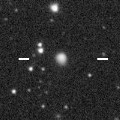
|
Now it is 14.2 mag (July 23, Artyom Novichonok). It is expected to brighten up to 7 mag in 2017 summer. In the Northern Hemisphere, it becomes low temporarily in summer, but it keeps observable in good condition until the highlight while the comet will be brightening. In the Southern Hemisphere, it is not observable until early 2017.
Date(TT) R.A. (2000) Decl. Delta r Elong. m1 Best Time(A, h)
Aug. 20 9 51.58 51 29.7 4.642 3.909 39 14.0 3:52 (213, 11)
Aug. 27 10 5.01 50 58.9 4.547 3.843 41 13.8 4:00 (216, 13)
|
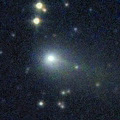
|
Now it is very bright as 12.5 mag (Aug. 3, Marco Goiato). It keeps observable in good condition for a while. But it will be fading after this.
Date(TT) R.A. (2000) Decl. Delta r Elong. m1 Best Time(A, h)
Aug. 20 20 56.26 -15 11.0 1.602 2.592 164 13.9 22:59 ( 0, 40)
Aug. 27 20 53.74 -15 46.4 1.650 2.612 157 14.0 22:29 ( 0, 39)
|

|
Now it is 13.6 mag (July 31, Chris Wyatt). Distant object, but it keeps observable at 14 mag for a long time from 2015 to 2016.
Date(TT) R.A. (2000) Decl. Delta r Elong. m1 Best Time(A, h)
Aug. 20 0 52.24 0 57.1 4.158 4.922 134 14.0 2:59 ( 0, 56)
Aug. 27 0 51.78 0 28.1 4.097 4.929 141 14.0 2:31 ( 0, 56)
|

|
It brightened up to 6 mag from autumn to winter. Now it is fading. It has already faded down to 14.5 mag (Aug. 5, Ken Harikae). It is observable in good condition in the Northern Hemisphere. It is not observable after this in the Southern Hemisphere.
Date(TT) R.A. (2000) Decl. Delta r Elong. m1 Best Time(A, h)
Aug. 20 6 4.88 50 11.4 4.432 4.028 60 14.3 3:52 (231, 42)
Aug. 27 6 5.38 50 49.5 4.405 4.103 66 14.4 4:00 (230, 47)
|
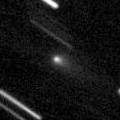
|
Now it is very bright as 13.9 mag (Aug. 13, Thomas Lehmann). It had been lost for a long time over 200 years since its discovery in 1783. The condition of this apparition is excellent, and it will brighten up to 14-15 mag in autumn. In the Northern Hemisphere, it will be getting higher rapidly after this, and will be observable in excellent condition from summer to winter. In the Southern Hemisphere, it keeps observable in good condition until November.
Date(TT) R.A. (2000) Decl. Delta r Elong. m1 Best Time(A, h)
Aug. 20 4 42.94 2 28.5 1.686 1.783 78 14.4 3:52 (298, 38)
Aug. 27 4 52.79 4 33.3 1.612 1.778 81 14.3 4:00 (302, 44)
|
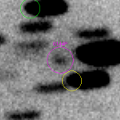
|
It became so bright as 8 mag in 2009. It was expected to brighten up to 11-12 mag from summer to autumn. But actually, it is 14.4 mag (Aug. 12, iTelescope SRO Observatory, Auberry), fainter than originally expected by 3 mag. It keeps locating low for a while.
Date(TT) R.A. (2000) Decl. Delta r Elong. m1 Best Time(A, h)
Aug. 20 7 48.26 19 49.2 2.193 1.437 31 14.5 3:52 (253, 11)
Aug. 27 8 12.07 18 27.4 2.172 1.432 32 14.3 4:00 (256, 12)
|

|
It is not observable now. It will be observable at 16.5 mag in September in the Northern Hemisphere, or in November in the Southern Hemisphere.
Date(TT) R.A. (2000) Decl. Delta r Elong. m1 Best Time(A, h)
Aug. 20 8 44.45 14 58.2 2.983 2.044 17 15.0 3:52 (250, -3)
Aug. 27 9 0.46 14 5.8 2.973 2.059 20 15.2 4:00 (253, 0)
|
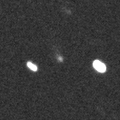
|
Now it is bright as 14.9 mag (May 4, Hidetaka Sato). It keeps 15 mag until autumn. In the Southern Hemisphere, it keeps observable for a long time. It will be unobservable after this in the Northern Hemisphere.
Date(TT) R.A. (2000) Decl. Delta r Elong. m1 Best Time(A, h)
Aug. 20 10 24.98 -57 56.5 2.536 2.398 70 15.2 20:13 ( 40,-42)
Aug. 27 11 1.63 -58 16.3 2.597 2.422 68 15.3 20:02 ( 40,-40)
|
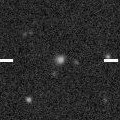
|
Now it is 16.4 mag (Aug. 12, Thomas Lehmann). It will be unobservable temporarily from summer to autumn. Then it will appear in the morning sky at 13 mag in December. It is expected to brighten up to 7 mag in 2017 spring. But it locates somewhat low at the high light.
Date(TT) R.A. (2000) Decl. Delta r Elong. m1 Best Time(A, h)
Aug. 20 11 49.98 -3 8.9 4.562 3.742 31 15.5 20:13 ( 90, -6)
Aug. 27 11 56.67 -3 45.8 4.539 3.668 27 15.4 20:02 ( 91, -8)
|
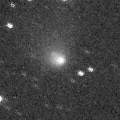
|
It brightened up to 13.0 mag in spring (May 6, Marco Goiato). It is already unobservable in the Northern Hemisphere. In the Southern Hemisphere, it keeps observable in good condition until autumn. But it will be fading slowly after this.
Date(TT) R.A. (2000) Decl. Delta r Elong. m1 Best Time(A, h)
Aug. 20 13 48.43 -28 53.6 2.591 2.427 69 15.7 20:13 ( 52, 1)
Aug. 27 14 0.16 -29 59.7 2.675 2.440 65 15.8 20:02 ( 52, 0)
|
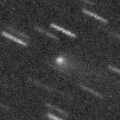
|
Now it is 15.9 mag (July 28, Ken-ichi Kadota), brighter than originally predicted. Now it is brightest. In the Southern Hemisphere, it keeps observable until winter, but it locates somewhat low. In the Northern Hemisphere, it will be getting higher after this, and it will be observable in excellent condition.
Date(TT) R.A. (2000) Decl. Delta r Elong. m1 Best Time(A, h)
Aug. 20 5 29.84 20 37.9 1.685 1.544 64 15.8 3:52 (271, 39)
Aug. 27 5 46.71 22 18.3 1.666 1.575 67 16.0 4:00 (272, 44)
|
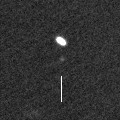
|
It is appearing in the morning sky in the Northern Hemisphere. It is expected to brighten up to 14 mag from winter to spring in 2017, and it will be observable in excellent condition in the Northern Hemisphere. In the Southern Hemisphere, it keeps extremely low until autumn, and it will be low also around the higlight.
Date(TT) R.A. (2000) Decl. Delta r Elong. m1 Best Time(A, h)
Aug. 20 7 50.67 28 36.8 3.348 2.568 33 16.1 3:52 (245, 15)
Aug. 27 8 5.53 28 28.0 3.281 2.550 37 15.9 4:00 (248, 19)
|
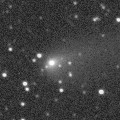
|
It was observed at 13 mag for a long time from winter to early summer. Now it is fading. It has already faded down to 15.7 mag (July 18, J. Gaitan). It is observable in excellent condition in the Southern Hemisphere. But it locates somewhat low in the Northern Hemisphere.
Date(TT) R.A. (2000) Decl. Delta r Elong. m1 Best Time(A, h)
Aug. 20 15 51.46 -23 47.5 2.384 2.648 93 16.0 20:13 ( 34, 23)
Aug. 27 15 59.64 -24 6.4 2.496 2.672 88 16.2 20:02 ( 36, 22)
|
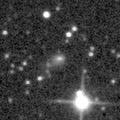
|
Now it is 15.5 mag (July 30, Yasukazu Ikari). It will be observable at 13 mag for a long time from 2017 to 2018. In 2016, it keeps observable at 16 mag in good condition until autumn.
Date(TT) R.A. (2000) Decl. Delta r Elong. m1 Best Time(A, h)
Aug. 20 18 56.77 -9 44.6 5.187 5.953 135 16.1 21:00 ( 0, 45)
Aug. 27 18 51.31 -9 36.6 5.236 5.910 127 16.1 20:27 ( 0, 45)
|

|
Now it is 15.9 mag (Aug. 13, Purple Mountain Observatory, XuYi Station). It will be observable at 16 mag in good condition from autumn to winter. It locates somewhat low in the Southern Hemisphere.
Date(TT) R.A. (2000) Decl. Delta r Elong. m1 Best Time(A, h)
Aug. 20 3 59.98 27 34.9 2.422 2.521 83 16.4 3:52 (275, 61)
Aug. 27 4 9.17 28 24.8 2.347 2.527 88 16.4 4:00 (278, 66)
|

|
Now it is 16.2 mag (June 29, iTelescope Observatory, Siding Spring). It keeps 16 mag for a long time until 2017. It is already unobservable in the Northern Hemisphere. It will be unobservable in October also in the Southern Hemisphere.
Date(TT) R.A. (2000) Decl. Delta r Elong. m1 Best Time(A, h)
Aug. 20 13 19.01 -20 31.1 3.763 3.364 59 16.4 20:13 ( 63, 2)
Aug. 27 13 28.40 -20 2.2 3.827 3.344 54 16.4 20:02 ( 65, 1)
|
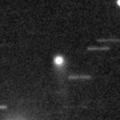
|
Now it is 15.8 mag (Aug. 7, T. Seki, H. Sato). It will brighten up to 14 mag from summer to winter in 2017. Then it will be observable in excellent condition in the Northern Hemisphere. In the Southern Hemisphere, it is hardly observable around the highlight.
Date(TT) R.A. (2000) Decl. Delta r Elong. m1 Best Time(A, h)
Aug. 20 0 11.70 -18 2.0 3.938 4.820 147 16.5 2:18 ( 0, 37)
Aug. 27 0 5.67 -17 58.7 3.847 4.776 153 16.4 1:45 ( 0, 37)
|

|
Now it is 16.1 mag (Aug. 6, Yuji Ohshima). It keeps 16.5 mag from 2016 to 2017. It is observable in good condition in the Northern Hemisphere. In the Southern Hemisphere, it locates low in 2016, and it is not observable in 2017.
Date(TT) R.A. (2000) Decl. Delta r Elong. m1 Best Time(A, h)
Aug. 20 16 31.48 34 53.0 6.216 6.292 89 16.7 20:13 ( 97, 70)
Aug. 27 16 31.57 34 35.3 6.276 6.287 85 16.8 20:02 ( 97, 67)
|
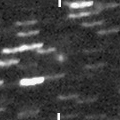
|
Now it is 16.6 mag (Aug. 4, A. Diepvens). It keeps 16-17 mag and keeps observable in good condition until autumn.
Date(TT) R.A. (2000) Decl. Delta r Elong. m1 Best Time(A, h)
Aug. 20 17 35.34 -11 16.5 2.043 2.648 116 16.7 20:13 ( 11, 43)
Aug. 27 17 37.82 -11 28.9 2.105 2.629 110 16.8 20:02 ( 16, 42)
|
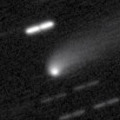
|
It brightened very rapidly in 2015 spring, and reached up to 13.8 mag (2015 May 11, Sandor Szabo). It kept 14-15 mag from winter to early summer in 2016. Now it is fading. It will be unobservable soon in the Northern Hemisphere. In the Southern Hemisphere, it keeps observable until October.
Date(TT) R.A. (2000) Decl. Delta r Elong. m1 Best Time(A, h)
Aug. 20 14 11.91 -24 56.8 4.806 4.602 72 16.9 20:13 ( 52, 8)
Aug. 27 14 17.72 -25 7.1 4.933 4.633 67 17.0 20:02 ( 53, 6)
|

|
It brightened up to 15 mag from late 2014 to early 2016. Now it is fading slowly. Now it is 16.1 mag (Aug. 16, D. Buczynski). In the Northern Hemisphere, it will be observable at 16-17 mag in autumn in good condition. It locates extremely low in the Southern Hemisphere.
Date(TT) R.A. (2000) Decl. Delta r Elong. m1 Best Time(A, h)
Aug. 20 23 10.45 44 18.2 4.486 5.080 120 16.9 1:17 (180, 81)
Aug. 27 22 58.13 44 27.9 4.466 5.112 124 16.9 0:38 (180, 80)
|

|
It has been lost since its discovery in 1978. In 2016, it is expected to return in excellent condition from autumn to winter.
Date(TT) R.A. (2000) Decl. Delta r Elong. m1 Best Time(A, h)
Aug. 20 19 33.69 -32 25.3 0.688 1.609 141 17.4 21:37 ( 0, 23)
Aug. 27 19 30.62 -32 38.7 0.681 1.564 134 17.0 21:06 ( 0, 22)
|
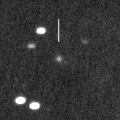
|
Now it is 18.5 mag (Aug. 11, CAO, San Pedro de Atacama). It will be observable at 16 mag in good condition from autumn to winter. It locates low in the Southern Hemisphere.
Date(TT) R.A. (2000) Decl. Delta r Elong. m1 Best Time(A, h)
Aug. 20 6 35.46 24 10.9 4.521 3.934 49 17.2 3:52 (259, 28)
Aug. 27 6 43.04 24 10.4 4.431 3.925 54 17.1 4:00 (262, 33)
|
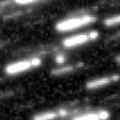
|
Now it is 17.4 mag (July 24, CAO, San Pedro de Atacama). It will brighten up to 16 mag and will be observable in good condition in 2017. In 2016, it is observable in excellent condition in the Southern Hemisphere, but it keeps low in the Northern Hemisphere.
Date(TT) R.A. (2000) Decl. Delta r Elong. m1 Best Time(A, h)
Aug. 20 18 37.62 -38 35.0 2.523 3.253 128 17.1 20:41 ( 0, 16)
Aug. 27 18 36.78 -38 0.1 2.581 3.235 122 17.1 20:13 ( 0, 17)
|

|
Now it is 17.9 mag (Aug. 8, J. Gonzalez). It keeps 17-18 mag until autumn. It keeps observable in excellent condition in the Northern Hemisphere. It will be getting lower gradually in the Southern Hemisphere.
Date(TT) R.A. (2000) Decl. Delta r Elong. m1 Best Time(A, h)
Aug. 20 20 24.60 36 37.3 1.585 2.331 126 17.2 22:25 (180, 88)
Aug. 27 19 59.15 37 29.8 1.653 2.347 121 17.3 21:33 (180, 87)
|

|
Now it is 17.1 mag (Aug. 12, iTelescope Observatory, Siding Spring). It will brighten up to 15 mag in winter. But it will be getting lower gradually after autumn.
Date(TT) R.A. (2000) Decl. Delta r Elong. m1 Best Time(A, h)
Aug. 20 22 37.58 -11 15.9 1.517 2.520 170 17.4 0:45 ( 0, 44)
Aug. 27 22 30.99 -11 15.1 1.466 2.476 177 17.2 0:11 ( 0, 44)
|
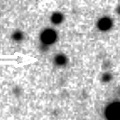
|
Now it is 16.9 mag (Aug. 13, S. Shurpakov). It will brighten up to 13 mag and will be observable in good condition in 2017 summer. In 2016, it keeps observable until winter when it will brighten up to 15.5 mag. It locates somewhat low in the Southern Hemisphere.
Date(TT) R.A. (2000) Decl. Delta r Elong. m1 Best Time(A, h)
Aug. 20 3 36.72 30 43.9 4.499 4.577 88 17.4 3:52 (272, 66)
Aug. 27 3 33.09 31 1.4 4.319 4.527 95 17.2 4:00 (279, 74)
|
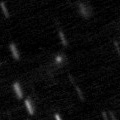
|
Now it is 18.0 mag (July 24, CAO, San Pedro de Atacama). It keeps 17 mag for a long time in 2016, and it will be observable in excellent condition in the Southern Hemisphere. It is hardly observable in the Northern Hemisphere.
Date(TT) R.A. (2000) Decl. Delta r Elong. m1 Best Time(A, h)
Aug. 20 3 12.15 -46 20.9 3.082 3.511 106 17.3 3:52 (345, 6)
Aug. 27 2 59.93 -47 52.3 3.033 3.529 111 17.3 4:00 (353, 7)
|

|
It brightened up to 13-14 mag from 2014 to 2015. Now it is fading. It has already faded down to 17.0 mag (Aug. 12, iTelescope Observatory, Siding Spring). It will be fainter than 18 mag in October.
Date(TT) R.A. (2000) Decl. Delta r Elong. m1 Best Time(A, h)
Aug. 20 23 19.02 -4 30.6 4.646 5.599 158 17.4 1:26 ( 0, 51)
Aug. 27 23 16.46 -4 55.9 4.659 5.644 165 17.4 0:56 ( 0, 50)
|

|
Now it is 17.5 mag (Aug. 4, Toshiyuki Takahashi). It will brighten up to 15 mag and will be observable in good condition from autum to winter in 2017. In the Northern Hemisphere, it keeps observable in good condition for a long time while the comet will be brightening. It is not observable until 2017 summer in the Southern Hemisphere.
Date(TT) R.A. (2000) Decl. Delta r Elong. m1 Best Time(A, h)
Aug. 20 5 19.34 56 30.6 6.088 5.793 68 17.6 3:52 (222, 48)
Aug. 27 5 18.57 56 54.6 5.952 5.757 74 17.5 4:00 (220, 53)
|
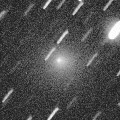
|
It brightened up to 10-11 mag in May. Now it is fading rapidly. It is already fainter than 17.0 mag (Aug. 6, Thomas Lehmann). It keeps observable in good condition until September.
Date(TT) R.A. (2000) Decl. Delta r Elong. m1 Best Time(A, h)
Aug. 20 14 57.59 9 0.2 2.289 2.225 73 17.5 20:13 ( 71, 39)
Aug. 27 14 56.62 6 22.1 2.482 2.296 67 18.0 20:02 ( 72, 34)
|
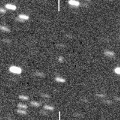
|
First return of a new periodic comet discovered in 2008. Now it is 18.8 mag (Aug. 1, M. Jaeger, E. Prosperi, S. Prosperi, W. Vollmann). It keeps observable at 17.5 mag until autumn.
Date(TT) R.A. (2000) Decl. Delta r Elong. m1 Best Time(A, h)
Aug. 20 20 9.49 -19 13.0 2.162 3.099 153 17.5 22:12 ( 0, 36)
Aug. 27 20 6.53 -19 18.9 2.206 3.093 145 17.5 21:42 ( 0, 36)
|

|
It will pass the perihelion in 2019. However, it has not been brightening since the discovery in 2010. Now it is 18.1 mag (Aug. 10, D. Buczynski). It keeps observable in excellent condition in the Northern Hemisphere. It is not observable in the Southern Hemisphere.
Date(TT) R.A. (2000) Decl. Delta r Elong. m1 Best Time(A, h)
Aug. 20 4 38.67 54 46.8 10.238 10.006 73 17.6 3:52 (223, 54)
Aug. 27 4 40.73 55 22.5 10.123 9.985 79 17.5 4:00 (219, 59)
|
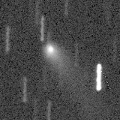
|
It was observed at 14-15 mag from 2014 to 2015. Now it is fading. It has already faded down to 17.3 mag (Aug. 10, D. Buczynski). In the Northern Hemisphere, it keeps observable in excellent condition until winter when the comet will be fainter than 18 mag. It is not observable in the Southern Hemisphere.
Date(TT) R.A. (2000) Decl. Delta r Elong. m1 Best Time(A, h)
Aug. 20 4 31.57 73 19.0 6.031 5.863 75 17.6 3:52 (196, 47)
Aug. 27 4 39.22 74 33.5 6.008 5.904 79 17.6 4:00 (193, 47)
|
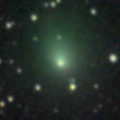
|
It brightened up to 10 mag in 2015 autumn. Now it is fading. It has already faded down to 16.1 mag (Aug. 16, Buczynski). It will be fainter than 18 mag in September.
Date(TT) R.A. (2000) Decl. Delta r Elong. m1 Best Time(A, h)
Aug. 20 3 34.99 14 2.0 2.798 3.014 92 17.6 3:52 (304, 58)
Aug. 27 3 37.85 14 1.5 2.737 3.053 98 17.7 4:00 (316, 63)
|

|
It brightened up to 3.7 mag and became a naked eye comet in mid January in 2015 (Jan. 13, Marek Biely). Now it is fading. It has already faded down to 16.7 mag (Aug. 9, Purple Mountain Observatory, XuYi Station). It will be fainter than 18 mag in September.
Date(TT) R.A. (2000) Decl. Delta r Elong. m1 Best Time(A, h)
Aug. 20 17 15.35 19 19.2 6.175 6.488 103 17.6 20:13 ( 41, 70)
Aug. 27 17 14.51 18 21.7 6.317 6.548 98 17.7 20:02 ( 48, 67)
|
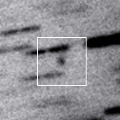
|
Now it is 17.4 mag (July 2, G. Gunn, G. W. Christie). It keeps observable at 17.5 mag in good condition from spring to autumn in the Southern Hemisphere. It is not observable in the Northern Hemisphere.
Date(TT) R.A. (2000) Decl. Delta r Elong. m1 Best Time(A, h)
Aug. 20 17 35.60 -59 48.4 4.488 4.971 112 17.7 20:13 ( 4, -5)
Aug. 27 17 38.33 -58 58.6 4.559 4.969 108 17.8 20:02 ( 6, -4)
|

|
Now it is 18.0 mag (Aug. 9, Jean-Francois Soulier). It has brightened in outburst up to 14 mag twice, in 2006 January and 2011 May. It is observable at 17 mag in good condition in autumn.
Date(TT) R.A. (2000) Decl. Delta r Elong. m1 Best Time(A, h)
Aug. 20 1 28.02 7 16.6 5.634 6.257 124 17.8 3:34 ( 0, 62)
Aug. 27 1 27.36 7 8.3 5.559 6.269 131 17.7 3:06 ( 0, 62)
|

|
Now it is 18.9 mag (Aug. 9, S. Maticic). It will be observable at 17.5 mag in good condition in autumn.
Date(TT) R.A. (2000) Decl. Delta r Elong. m1 Best Time(A, h)
Aug. 20 23 16.56 4 44.6 1.711 2.658 153 17.9 1:23 ( 0, 60)
Aug. 27 23 13.45 4 39.2 1.654 2.629 160 17.8 0:53 ( 0, 60)
|

|
It is 17.2 mag now (Aug. 5, Toshiyuki Takahashi). It was expected to brighten up to 16 mag and observable in good condition in autumn. But actually, it is fainter than originally predicted by 2 mag.
Date(TT) R.A. (2000) Decl. Delta r Elong. m1 Best Time(A, h)
Aug. 20 23 9.36 -11 45.3 1.861 2.843 162 17.9 1:16 ( 0, 43)
Aug. 27 23 4.65 -11 51.5 1.823 2.823 169 17.8 0:44 ( 0, 43)
|

|
It has not been recovered in this apparition yet. It is expected to brighten up to 16.5 mag and will be observable in good condition from autumn to winter.
Date(TT) R.A. (2000) Decl. Delta r Elong. m1 Best Time(A, h)
Aug. 20 3 19.20 -8 41.2 2.248 2.637 101 18.0 3:52 (329, 41)
Aug. 27 3 25.63 -9 5.7 2.149 2.610 105 17.8 4:00 (338, 43)
|

|
It was observed as bright as 13-14 mag for a long time from 2011 to 2014. Now it is fading. It is observable in excellent condition in the Southern Hemisphere. It locates extremely low in the Northern Hemisphere. No observations have been reported since August, 2015.
Date(TT) R.A. (2000) Decl. Delta r Elong. m1 Best Time(A, h)
Aug. 20 16 58.49 -37 32.8 9.518 9.903 109 17.8 20:13 ( 14, 16)
Aug. 27 16 56.83 -37 31.8 9.665 9.937 102 17.9 20:02 ( 18, 15)
|
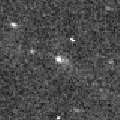
|
First return of a new periodic comet which brightened up to 16.5 mag in 2008. The condition of this apparition is very good. It was expected to brighten up to 15.5 mag in autumn and will be observable in good condition. But actually, it is 18.4 mag (Aug. 12, ATLAS-HKO, Haleakala), fainter than originally expected by 3 mag.
Date(TT) R.A. (2000) Decl. Delta r Elong. m1 Best Time(A, h)
Aug. 20 0 24.89 -16 24.8 1.505 2.400 144 18.2 2:31 ( 0, 39)
Aug. 27 0 20.00 -15 58.2 1.452 2.386 150 18.1 1:59 ( 0, 39)
|
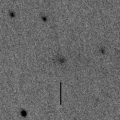
|
Now it is 17.1 mag (July 9, Kunihiro Shima). It was expected to brighten up to 14 mag from winter to summer. But it is much fainter actually. It will be observable in excellent condition in the Southern Hemisphere. It locates low in the Northern Hemisphere.
Date(TT) R.A. (2000) Decl. Delta r Elong. m1 Best Time(A, h)
Aug. 20 16 27.95 -37 57.0 2.883 3.271 103 19.3 20:13 ( 20, 13)
Aug. 27 16 34.72 -37 46.5 3.023 3.324 98 19.5 20:02 ( 22, 13)
|
|
![]()
 29P/Schwassmann-Wachmann 1
29P/Schwassmann-Wachmann 1 C/2015 TQ209 ( LINEAR )
C/2015 TQ209 ( LINEAR ) C/2016 A8 ( LINEAR )
C/2016 A8 ( LINEAR ) C/2014 W2 ( PanSTARRS )
C/2014 W2 ( PanSTARRS ) C/2015 V2 ( Johnson )
C/2015 V2 ( Johnson ) 53P/Van Biesbroeck
53P/Van Biesbroeck C/2011 KP36 ( Spacewatch )
C/2011 KP36 ( Spacewatch ) C/2013 US10 ( Catalina )
C/2013 US10 ( Catalina ) 226P/Pigott-LINEAR-Kowalski
226P/Pigott-LINEAR-Kowalski 144P/Kushida
144P/Kushida 118P/Shoemaker-Levy 4
118P/Shoemaker-Levy 4 C/2015 T4 ( PanSTARRS )
C/2015 T4 ( PanSTARRS ) C/2015 ER61 ( PanSTARRS )
C/2015 ER61 ( PanSTARRS ) 77P/Longmore
77P/Longmore 146P/Shoemaker-LINEAR
146P/Shoemaker-LINEAR 315P/2013 V6 ( LONEOS )
315P/2013 V6 ( LONEOS ) 116P/Wild 4
116P/Wild 4 C/2015 O1 ( PanSTARRS )
C/2015 O1 ( PanSTARRS ) 56P/Slaughter-Burnham
56P/Slaughter-Burnham C/2016 B1 ( NEOWISE )
C/2016 B1 ( NEOWISE ) C/2016 N4 ( MASTER )
C/2016 N4 ( MASTER ) C/2014 OE4 ( PanSTARRS )
C/2014 OE4 ( PanSTARRS ) 219P/LINEAR
219P/LINEAR C/2014 W11 ( PanSTARRS )
C/2014 W11 ( PanSTARRS ) C/2014 A4 ( SONEAR )
C/2014 A4 ( SONEAR ) D/1978 R1 ( Haneda-Campos )
D/1978 R1 ( Haneda-Campos ) 74P/Smirnova-Chernykh
74P/Smirnova-Chernykh 47P/Ashbrook-Jackson
47P/Ashbrook-Jackson C/2016 K1 ( LINEAR )
C/2016 K1 ( LINEAR ) 93P/Lovas 1
93P/Lovas 1 C/2015 VL62 ( Lemmon-Yeung-PanSTARRS )
C/2015 VL62 ( Lemmon-Yeung-PanSTARRS ) C/2015 B2 ( PanSTARRS )
C/2015 B2 ( PanSTARRS ) C/2012 F3 ( PanSTARRS )
C/2012 F3 ( PanSTARRS ) C/2015 V1 ( PanSTARRS )
C/2015 V1 ( PanSTARRS ) C/2015 WZ ( PanSTARRS )
C/2015 WZ ( PanSTARRS ) 340P/2016 N2 ( Boattini )
340P/2016 N2 ( Boattini ) C/2010 U3 ( Boattini )
C/2010 U3 ( Boattini ) C/2014 N3 ( NEOWISE )
C/2014 N3 ( NEOWISE ) 22P/Kopff
22P/Kopff C/2014 Q2 ( Lovejoy )
C/2014 Q2 ( Lovejoy ) C/2015 H2 ( PanSTARRS )
C/2015 H2 ( PanSTARRS ) 174P/(60558) 2000 EC98 ( Echeclus )
174P/(60558) 2000 EC98 ( Echeclus ) 343P/2016 P3 ( NEAT-LONEOS )
343P/2016 P3 ( NEAT-LONEOS ) 188P/LINEAR-Mueller
188P/LINEAR-Mueller P/2007 T6 ( Catalina )
P/2007 T6 ( Catalina ) C/2010 S1 ( LINEAR )
C/2010 S1 ( LINEAR ) 339P/2016 N1 ( McNaught )
339P/2016 N1 ( McNaught ) C/2014 Y1 ( PanSTARRS )
C/2014 Y1 ( PanSTARRS )![]()


















































